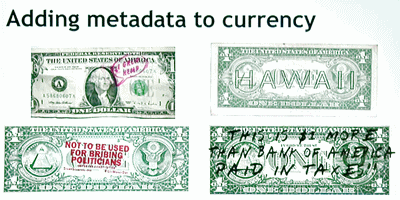While working through the lectures, I've noted a few topics worth pursuing on this blog.
The next lecture topic I noted is 'Bitcoins as "Smart Property"', which is covered in section 9.2 of the course textbook:-
Now we’ll talk about using bitcoins to represent something other than a unit of currency in the Bitcoin system. [...]
Fungibility: This also leads to an interesting observation: bitcoins aren't fungible. In economics, a fungible good is one where all individual units are equivalent and can be substituted for one another. For example, gold is fungible since one ounce of (pure) gold can be substituted for any other ounce of gold. But this isn’t always true of Bitcoin because every bitcoin is unique and has a different history. [...]
Smart Property: Could this non-fungibility property be useful? We’ve already seen why it can be bad for privacy because of the potential for deanonymizing users. In this section we’ll look at why it can also be useful to give meaning to the history of a bitcoin.
The clever example to illustrate this topic is 'writing on currency'. A few examples were given in the corresponding lecture.

Left to right, top to bottom:
'I [George Washington] grew hemp'
'HAWAII'
'Not to be used for bribing politicians'
'This is $1 more than Bank of America paid in taxes!'
The textbook explains,
Let's think about what it would mean to give meaning to the history of ordinary offline physical currency. Suppose we wanted to add metadata to offline currency. In fact, some people already do this. For example, they like to write various messages on banknotes, often as a joke or a political protest. This generally doesn’t affect the value of the banknote, and is just a novelty.
I wasn't sure about the legality of this, but Yes, It's Legal! (stampstampede.org):-
Many people assume that it’s illegal to stamp or write on paper currency, but that’s not the case. It’s illegal to destroy paper currency or deface it so much that it’s no longer recognizable and has to be taken out of circulation.
That is not the case in the examples shown above. Back to bitcoin and the Princeton text:-
But what if we could have authenticated metadata attached to our currency -- metadata that cannot easily be duplicated? One way to achieve this is to include a cryptographic signature in the metadata we write, and tie this metadata to the serial number of the banknote.
And that opens the blockchain to a new universe of potential uses. I'll explore these in another post.
No comments:
Post a Comment